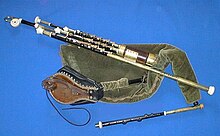Uilleann pipes
Uilleann Pipes [ ˌɪlənpaɪps ] (of ir. Uilleann [ iːlʲən̪ˠ ] (ir. Pioban-Uilleann) "elbow" and English. Pipes "pipes") is the name for the Irish bagpipes . The naming is based on the fact that the Uilleann Pipes are not supplied with air with the mouth, but with a bellows operated with the elbow. Other names are Union Pipes and Irish Pipes .
They were developed in the form commonly used today in the 18th century (approx. 1760–1780) and have not changed much since then. Their sound can be described as relatively delicate and soft (compared to the sharp sound of the Great Highland Bagpipes ).
The uilleann pipes are played while seated. Bellows sit under the right arm and the sack under the left. The three drones ( drone whistles ) lie across the player's lap. They can be switched on or off via an operable valve. In addition, there are so-called regulators, usually three of them. This is to gedackte pipes with valves are provided and only give when you press a flap a sound. The flaps of the regulators are operated with the right edge of the hand or the right thumb when playing and generate accompanying chords . The melody pipe, called “chanter”, is equipped with a double reed and has a pitch range of two octaves , whereby the second octave is achieved by “overblowing”, ie increasing the wind pressure. Except when playing the lowest note, the end of the chanter rests on the player's thigh. If he keeps all finger holes closed , the player can interrupt the sound ( staccato ).
Without keys on the chanter, the C (as a minor seventh above the root D) can be generated from the semitones , so that G and E minor can also be played. In addition, without keys, only using forked handles, D-flat or E-flat is also possible in both octaves. These tones are used both as a leading tone in E minor and, in rare cases, as a tone in a through and alternating chord in C minor, usually referred to as "Ghost D". Pieces of music recorded in writing, so-called “tunes”, are notated in D, even if the actual sounding mood differs from D; so the uilleann pipes are transposing instruments . If a uilleann pipe is tuned to sound in D, it is called a concert pitch. Other sounding tunings are C sharp, C, B and B, these are collectively called "flat pipes" or "flat-pitched pipes".
Due to the demanding coordination of arm, hand and finger movements when operating the bellows, windsock, chanter, regulators and drones, the Uilleann Pipes are probably the most difficult type of bagpipe to play, but probably also the one with the highest musical expressiveness.
The Uilleann Pipes are mainly made from the very dark African hardwood grenadilla or from black ebony . In addition, there have always been instruments made of boxwood and fruitwood such as plum or maple. The metal parts are made from brass or silver, the decorative rings from ivory, nowadays more from boxwood, plastic or (cattle) horn.

